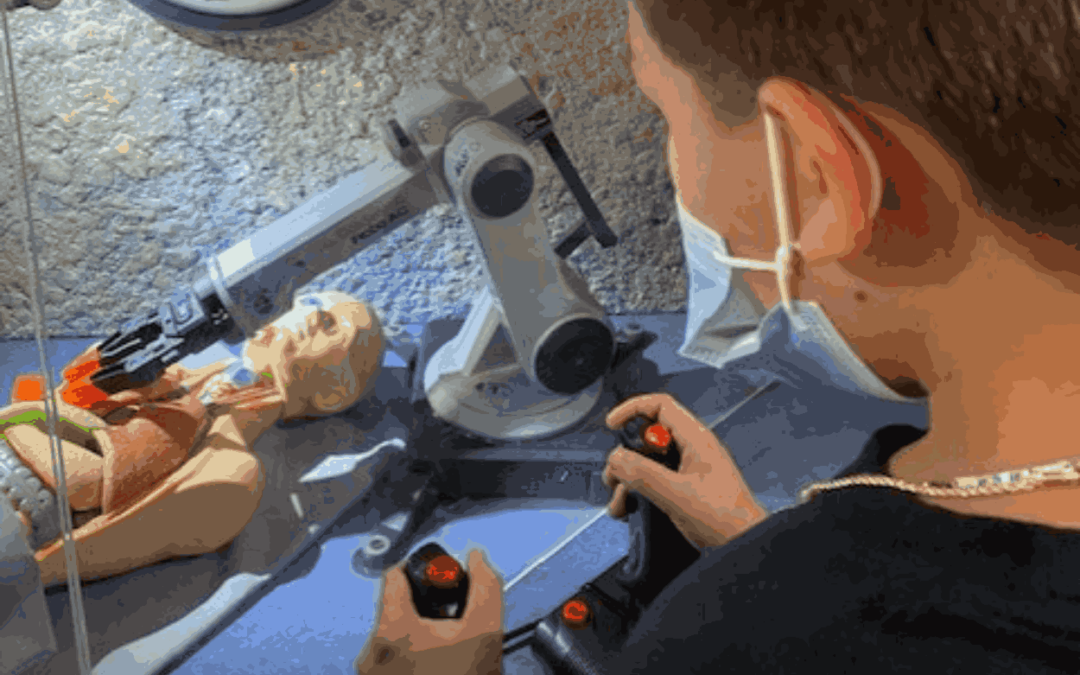By Robin Harkey
Hands-on—inquiry-based—and through trial and error—an engineer uses the design process to “ask, imagine, plan, create, test, and improve” upon a problem or need.
This particular way of thinking which methodically examines and provides solutions was also demonstrated when assistant principal Tricia Foerster proposed bringing an interactive science museum on wheels, the Texas Alliance of Minorities in Engineering (TAME) Trailblazer, to Hopkins Elementary.
Paid for from a grant from the VISD Education Foundation initially planned for the 2020-2021 school year, Foerster wanted more for her school, seeking to create “greater engagement and interest in STEM careers” concentrated on engineering fields such as space, energy, aerodynamics, biotechnology, and weather.
Upon entry into the 40-foot trailer, on a cloudy mid-December day, my eye gravitated to the biotechnology section, where a robotic surgery arm and two Atari-style joysticks were on display to control a surgery simulation process involving the removal of a faux green organ.
Students found the activity challenging yet entertaining as they lingered, trying their hand at being a medical hero for the day, with no Operation game buzzers or negative reinforcement tactics to deter their curiosity and focus.
My second favorite rotation was space. Here lab coat clad fifth grade science teacher Alfred Gomez introduced students to the NASA Space Station tracker in full force along with Osearch, an aquatic life GPS tracking system powered by SeaWorld.
Using this technology, scientists monitor the location, number, type, and for some, the length and weight of each animal. Specific species include tiger sharks, white sharks, shortfin mako sharks, and many more, with catchy and endearing names such as Zozo, Rose, and Buc-ee, named by marine biologists, more specifically, elasmobranchologists — those that study sharks.
Now it was time to check in on the weather by exploring careers such as meteorology and physics.
First up was the green screen where students could see themselves against a USA map to present the weather. One student asked instructional coach Amy Aitchison “How much does a meteorologist make?” without being prompted, which made her beam in delight. Aitchison also added that she “enjoyed having real-world conversations about what a future could look like…and even for careers not yet created.”
Last on my stop were the aerodynamics and energy stations, where kids tinkered with pressure and wind tunnels using ping pong balls, tubes, and hairdryers as a volunteer discussed jobs such as aerospace engineering and piloting with impressive salaries of $118K and 108K, respectively.
Before leaving, I was about out of steam, but the energy station got me going again with smiles and fun experimenting with an energy stick and open and closed circuitry and bubbling bright colored hand boilers to teach kids about the energy emitted from your hands and body.
As a part of Foerster’s grant evaluation, all fourth and fifth grade participants were given a pre- and post-experience survey. Results from the assessment indicated that career interest rose by 34%, increasing from 50% to 84%, across surveys, with a majority of students expressing that they wanted more information on STEM careers.
This result is excellent news considering that 64% of students were unaware of the meaning of STEM (science, technology, engineering, and math) before encountering the Trailblazer. From a qualitative view of student outcomes, Foerster added that they “saw STEM careers in a new way and made connections to their classroom learning”— a welcome bridge we hope continues to be built in time.
So, won’t you help us build into the lives of students in VISD with projects such as these and others? How? Give a meaningful year-end contribution, with checks made payable to the “VISD Education Foundation” and mail to 102 Profit Drive Victoria, Texas 77901. Growing greatness since 2008, the VISD Education Foundation (#74-2597286) is a tax-exempt 501(c)(3) nonprofit organization.

